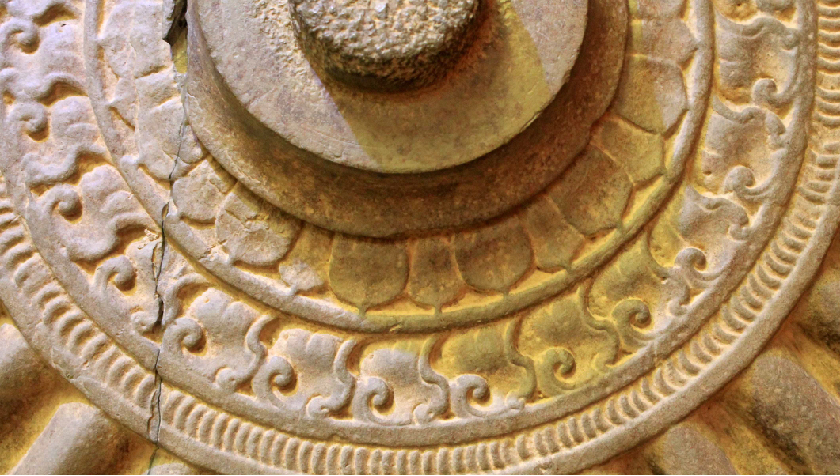
ลายบัวรวนในศิลปะทวารวดี : ที่มา และความสัมพันธ์กับศิลปกรรมในดินแดนเอเชียตะวันออกเฉียงใต้
The Jutting Leaf Pattern in Dvaravati Art : Source and Relations with Art in Southeast Asia
โดย พงษ์ศักดิ์ นิลวร / By Pongsak Nillavorn
Damrong Journal, Vol 16, No.2, 2017
บทคัดย่อ:
ลายบัวรวน เป็นลายรูปแบบหนึ่งที่พบในศิลปะทวารวดี ลักษณะของลายเป็นใบไม้คล้ายใบผักกาดส่วนปลายใบม้วนลง มีส่วนหัวใหญ่และที่ปลายด้านล่างค่อยๆ เล็กลงมา การประดับลายจะเรียงเป็นแถวต่อเนื่องกันไป ต้นแบบของลายบัวรวนอาจมีที่มาจากลายวยาลมาลาในศิลปะอินเดียภาคใต้พบตั้งแต่ศิลปะปัลลวะเป็นต้นมา ซึ่งนิยมใช้ประดับตกแต่งสถาปัตยกรรม ลายนี้ถูกปรับเปลี่ยนจนเป็นลักษณะเฉพาะเมื่อเข้าสู่ดินแดนเอเชียตะวันออกเฉียงใต้ กลายเป็นลายบัวรวนในศิลปะเขมรสมัยก่อนเมืองพระนครและศิลปะทวารวดี ในศิลปะเขมรสมัยก่อนเมืองพระนครนิยมใช้ลายบัวรวนประดับสถาปัตยกรรมเช่นเดียวกับสถาปัตยกรรมอินเดียภาคใต้ สำหรับในศิลปะทวารวดีพบทั้งลายที่ประดับอยู่ร่วมกับสถาปัตยกรรมและลายที่ใช้ประดับตกแต่งประติมากรรมด้วยเช่นกัน จากการศึกษาเปรียบเทียบรูปแบบของลายบัวรวนในศิลปะทวารวดีพบว่าค่อนข้างมีความสัมพันธ์กับลายบัวรวนในศิลปะเขมรสมัยก่อนเมืองพระนครอย่างมาก ขณะเดียวกันก็พบว่าลายบัวรวนในศิลปะทวารวดีนั้นมีความแตกต่างจากศิลปะเขมรสมัยก่อนเมืองพระนครในบางประการ ลักษณะดังกล่าวนี้แสดงให้เห็นถึงการคลี่คลายและวิวัฒนาการที่เกิดขึ้นเสมอๆ ในศิลปะทวารวดี นอกจากนี้ยังสะท้อนให้เห็นบริบททางด้านสังคมและวัฒนธรรมที่มีการติดต่อสัมพันธ์กันระหว่างรัฐโบราณร่วมสมัยในดินแดนเอเชียตะวันออกเฉียงใต้ด้วยกันเองอีกด้วย
ABSTRACT:
The jutting leaf pattern is like a leafy lettuce leaf rolled down. It has a large head which has been gradually lowered to the bottom and the decorations are arranged in a row. The prototype of the pattern may have been derived from the vyalamala pattern of southern India, based on Pallava art, which is used to decorate architecture. This pattern was transformed into a unique feature when it entered South East Asia, becoming a jutting leaf pattern in Cambodia which also found its way into Dvaravati art. In Pre-Angkorian Khmer art, the leaf pattern was used to decorate architecture as well as the architecture of southern India. As for the art of Dvaravati, the pattern is used to decorate architecture and sculpture. From the comparative study of the jutting leaf pattern in Dvaravati art it was found that similar patterns existed in early Khmer art. At the same time, it was found that the jutting leaf pattern in Dvaravati art is different from some earlier Khmer art. This style demonstrates the unraveling and evolution that always occurs in Dvaravati art. It also reflects the context of social and cultural relationship between ancient states of contemporary Southeast Asia.











